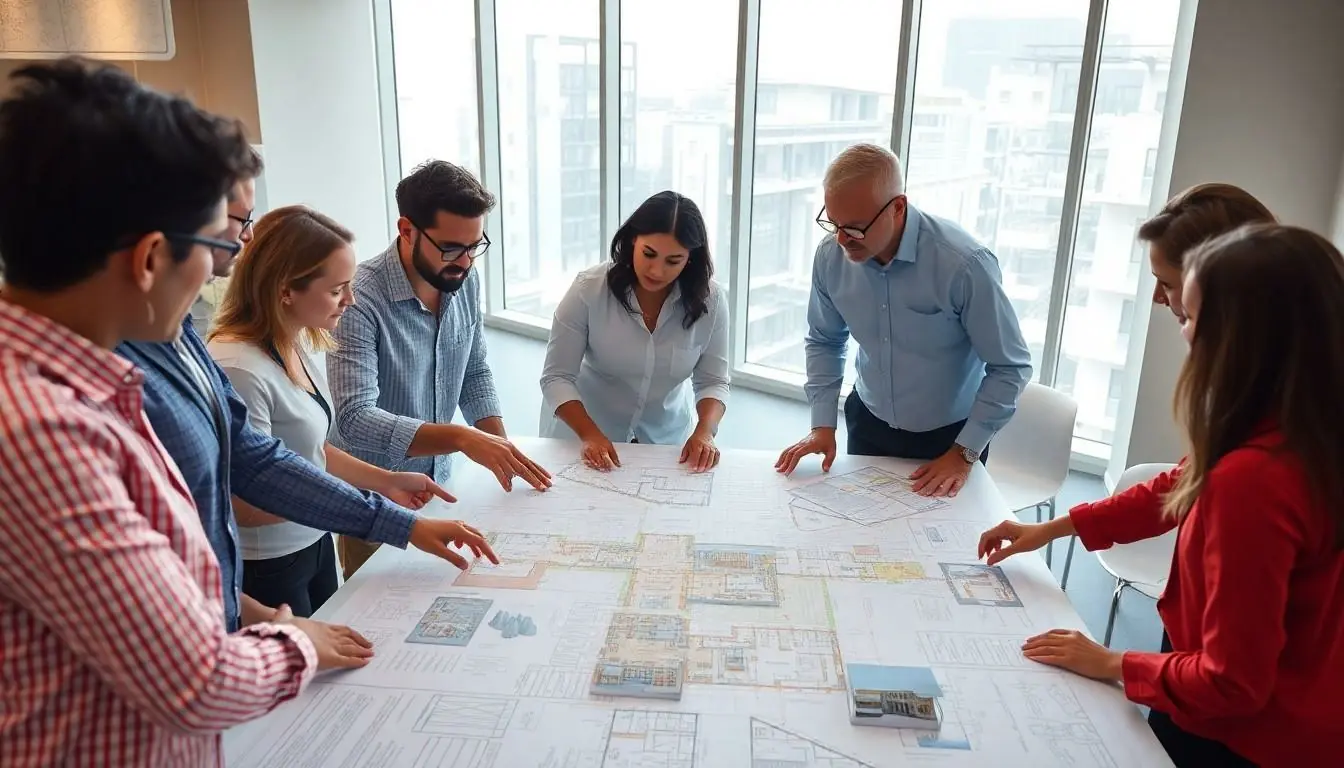Table of Contents
ToggleArchitecture design drawing is the secret sauce that transforms wild ideas into stunning structures. Think of it as the blueprint for dreams, where creativity meets precision in a dance that even the most skilled architects can appreciate. Whether it’s a cozy cottage or a skyscraper that kisses the clouds, these drawings are the first step in turning visions into reality.
Overview Of Architecture Design Drawing
Architecture design drawing plays a vital role in the development of structures. These drawings translate abstract concepts into concrete representations that guide the construction process. Architects create detailed schematics containing measurements, materials, and spatial relationships. Each drawing serves as a reference point, ensuring that technical specifications align with the creative vision.
Blueprints represent one type of architecture design drawing. These detailed plans illustrate every structural component, from the foundation to the roof. They often include various views, such as floor plans, sections, and elevations, highlighting both interior and exterior perspectives. Additionally, architects utilize 3D models to enhance visualization of the design, providing a more intuitive understanding of the space.
Each design drawing requires accuracy and attention to detail. Dimensioning plays a crucial role in ensuring that all elements fit together seamlessly. Proper scale and proportions maintain the project’s integrity, whether it involves residential, commercial, or institutional buildings.
Collaboration among architects, engineers, and contractors hinges on these drawings. Effective communication of design intent facilitates a smoother construction process. Professionals review drawings at multiple stages to address potential issues before actual work begins.
Software advancements simplified architecture design drawing. Tools like AutoCAD and SketchUp allow architects to create complex designs efficiently and share them easily with stakeholders. Digital formats promote innovation while simplifying revisions, enabling teams to respond to feedback swiftly.
Ultimately, architecture design drawing encompasses creativity and technicality. It embodies the marriage of artistic vision and practical application, promoting the successful realization of diverse architectural projects. Each drawing aids in navigating complexities, ensuring that each structure reflects the intended purpose and aesthetic value.
Importance Of Architecture Design Drawing

Architecture design drawing is essential for turning creative ideas into reality. These drawings function as blueprints, marrying artistry with technicality to facilitate the construction process.
Visualization Of Concepts
Visualization serves a primary role in architecture design drawing. It transforms abstract ideas into tangible forms, helping architects and clients understand the project better. Detailed drawings provide an accurate depiction of structures, showcasing spatial relationships and material choices. Overall, this visual clarity aids in preventing misinterpretations and ensures everyone involved aligns with the architectural vision. Enhanced visualization benefits not just architects but also clients and stakeholders. It invites feedback early in the design process, making adjustments simpler.
Communication Tool
Architecture design drawings act as vital communication tools among various professionals. Architects use these drawings to convey their intentions clearly to engineers and contractors. Each drawing detail, from scales to annotations, provides essential information for accurate construction. Effective communication fosters collaboration, reducing the chances of costly errors during the build. Enhanced collaboration among team members streamlines workflows and accelerates project timelines. By transforming complex ideas into straightforward visuals, architecture design drawings establish a common language that unites diverse expertise for successful project completion.
Types Of Architecture Design Drawings
Architecture design drawings come in different types, each serving unique purposes in the design and construction process. Understanding these types enhances communication and collaboration among architects, engineers, and contractors.
Conceptual Drawings
Conceptual drawings represent initial ideas and visions. They focus on conveying the overall concept rather than precise details. Sketches and watercolors often capture the project’s essence, illustrating spatial relationships and aesthetics. These drawings allow architects to explore design possibilities while engaging clients in the creative process. By showcasing alternative design paths, conceptual drawings foster collaborative discussions. Feedback from stakeholders can shape the direction of the project. These informal visuals set the stage for further development and refinement.
Technical Drawings
Technical drawings provide critical details needed for construction. These drawings include floor plans, sections, elevations, and detailed schematics. Each component features accurate measurements, material specifications, and construction techniques. Precision becomes vital, ensuring every element fits according to the overall design intent. Engineers and contractors rely heavily on these drawings for guidance during construction. Annotation and scaling play crucial roles in communicating intricate details. Effective technical drawings minimize misinterpretations and enhance accuracy on-site. Clarity in these documents streamlines collaboration and helps prevent costly errors throughout the build.
Tools And Techniques For Drawing
Architecture design drawing employs various tools and techniques that cater to both traditional and modern methodologies. These methods enhance precision and creativity in architectural representations.
Traditional Drawing Methods
Pencil and paper remain essential for architects who prefer traditional drawing methods. This approach often includes hand-drawn sketches and detailed blueprints created with instruments like rulers and compasses. They initially represent concepts and evolve into comprehensive plans. Additionally, watercolors and markers help illustrate ideas visually, allowing architects to communicate their intentions effectively. Drafting tables provide a stable workspace, enabling detailed work on scale drawings. This tactile process also fosters a deeper connection between architects and their designs, allowing them to express creativity clearly.
Digital Drawing Software
Software like AutoCAD, SketchUp, and Revit revolutionizes how architects create drawings. These tools streamline the design process, offering features like 3D modeling and real-time collaboration. Users can easily manipulate elements and visualize projects in various perspectives. Digital packages facilitate precise dimensioning, ensuring accuracy in architectural drawings. The ability to integrate with simulation tools helps architects analyze structural integrity and performance, making designs more robust. Moreover, digital formats simplify sharing and updating, promoting teamwork among architects, engineers, and contractors. The transition from traditional to digital methods signifies a significant evolution in architecture design drawing, improving overall efficiency and project outcomes.
Best Practices For Creating Effective Drawings
Creating effective architecture design drawings relies on clarity and precision to convey complex ideas. These elements ensure that every detail aligns with the architect’s vision.
Clarity And Precision
Clarity stands as a cornerstone of effective architecture design drawings. Each line, label, and measurement must communicate information unambiguously. Proper scaling enables accurate representation of dimensions, ensuring that every element appears in proportion. When offering annotations, use straightforward language that defines components clearly. By presenting organized layouts, architects enable easier navigation through the drawings, reducing confusion during construction. Visual hierarchy should guide viewers’ attention, highlighting essential features and relationships within the design. This level of clarity minimizes errors by ensuring everyone involved shares the same understanding of the project.
Incorporating Feedback
Incorporating feedback enhances the design drawing process. Initial concepts often benefit from input gathered during collaborative discussions. Engaging clients and stakeholders early encourages input that aligns the design with their expectations. Adjustments based on constructive feedback refine project direction, leading to more comprehensive architectural solutions. Tracking revisions can help designers maintain clarity throughout the process. Utilizing software tools that allow for seamless updates streamlines incorporating suggested changes. This iterative approach not only improves design quality but also fosters a sense of ownership among all participants. Ultimately, regular feedback loops create drawings that resonate with client needs while addressing technical requirements effectively.
Architecture design drawing stands as a cornerstone in the journey from concept to construction. Its ability to blend creativity with technical precision ensures that architects can effectively communicate their visions. The evolution of tools and techniques has only enhanced this process, allowing for greater collaboration and accuracy.
By prioritizing clarity and detail in each drawing, architects can minimize misunderstandings and streamline the construction process. Engaging clients early and incorporating feedback fosters a sense of ownership and satisfaction. Ultimately, architecture design drawing not only shapes the physical structures of our environment but also enriches the collaborative spirit that drives successful architectural projects.







